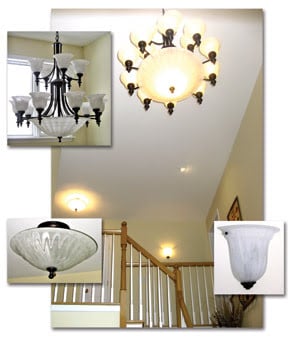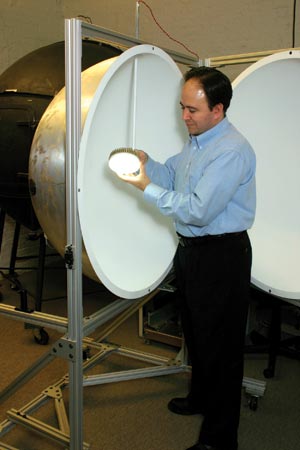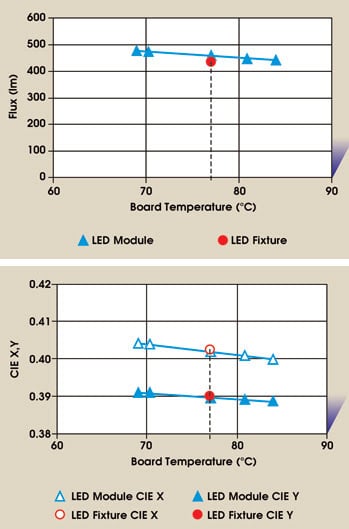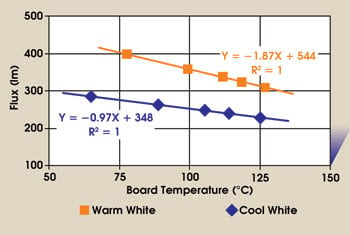With LEDs the next up-and-coming light source for fixtures, tests that accurately reflect their performance in real applications are needed.
Dr. Nadarajah Narendran, Jennifer Taylor, Jean Paul Freyssinier and Dr. Lalith Jayasinghe, Lighting Research Center
As the performance of white LEDs has improved, general lighting has become one of the next target applications for LEDs. Although general lighting applications requiring large amounts of light output may take longer to become a reality, applications such as decorative lighting now are within reach of white LED technology, which features energy savings and reduced maintenance. Decorative fixtures used in general lighting applications — which typically use incandescent, halogen and compact fluorescent light sources — are designed to be attractive while providing some amount of ambient lighting. LED-based decorative fixtures typically use an “LED module” consisting of an array of LEDs, an electronic driver and a heat sink.

Traditionally, manufacturers have not provided photometric data for decorative lighting fixtures; they specify only the type of lamp and its maximum allowable wattage. With incandescent lamps, users generally have a certain expectation for light level for a given wattage, and they know that these lamps last about two to three years in a home application. Likewise, users have certain expectations about compact fluorescents but this is true more so among commercial and hospitality customers because compact fluorescents are still not common in home applications in the US. The LED, in contrast, is the least understood light source, but its promise and reputation have become more widespread.
Establishing an LED test
For many years, agencies worldwide have been using performance standards and labels to promote energy-efficient light fixtures. For many traditional light sources, such as incandescent and halogen, the light source’s performance as measured under standard conditions will not change when it is put into a fixture. However, this is not the case for the LED because its life and overall performance are highly dependent on the temperature of its p-n junction, which changes depending on ambient environment, fixture design and installation. Therefore, the question is how to evaluate the performance of LED modules in decorative lighting fixtures. Our past research has shown that the LED board temperature can be used to predict LED performance because the junction temperature and board temperature are closely related as thermally linked points.

Figure 1. LED module performance testing is executed inside an integrating sphere.
Based on this information, we have developed a test procedure for estimating the performance of LED modules used in decorative lighting fixtures. The first step is to characterize the LED module as a function of board temperature, which is accomplished by placing the module inside a thermal chamber that holds the board temperature constant while the photometric, colorimetric and electrical parameters are measured in an integrating sphere. Even though, traditionally, light sources and lighting fixtures are tested at a reference ambient temperature, in the case of LEDs, the reference temperature should be the board temperature.
Data on light output, efficacy, color and life span gathered at three temperatures helps to show how each of these parameters changes with temperature. The range of test temperatures ought to cover the possible operating temperatures of the fixtures when used in realistic conditions. The next step is to measure the board temperature of the LED module when it is used in the lighting fixture for which it is intended in its application environment. This temperature is used to estimate the performance of the LED module. The proposed method is under review by the Alliance for Solid-State Illumination Systems and Technologies for publication under the auspices of its ASSIST recommends program.
ASSIST was established in 2002 by the Lighting Research Center at Rensselaer Polytechnic Institute in Troy, N.Y., as a collaboration among academic researchers, manufacturers and government organizations. The program’s goal is to facilitate the broad adoption and effective use of reliable, energy-efficient solid-state lighting and to speed its market acceptance.
The alliance provides a set of formal recommendations to the LED and lighting communities about issues important for the reliable performance of LED lighting and about its comparison with other light-source technologies.

Figure 2. Light output and chromaticity for a tested LED module are shown as a function of LED board temperature.
Performing the test
To validate the proposed test procedure, several commercial LED modules were obtained and characterized as a function of board temperature. After a sample LED module was placed in a test chamber that precisely controls the board temperature, the chamber was placed inside an integrating sphere for measurement. The measured data show the light-output and International Commission on Illumination (CIE) chromaticity values (X,Y) as a function of board temperature for one module tested (Figure 2). Graphs show that the light output and the color coordinates change linearly with temperature in the range tested.
Next, the same LED module was placed inside a prototype light fixture, and the entire fixture was tested in an integrating sphere. The board temperature was measured simultaneously. The fixture’s measured light output and CIE X,Y values are plotted in Figure 2 at their corresponding board temperature value. The measured light output and CIE X,Y values of the fixture compare well with the measured values of the LED module during the characterization study. Therefore, once an LED module’s performance is characterized as a function of temperature, the performance of the LED module in any decorative fixture can be estimated by measuring the board temperature of the module.
It is worth noting that, if even one component in the module is changed, the test must be repeated to obtain results for the modified module. For example, two similar LED modules may have different LEDs — one could be cool-white and the other warm-white, in which case the test is repeated for each (Figure 3).

Figure 3. The light-output data is shown for two similar commercial modules, one with cool-whites and the other with warm-whites. Both modules have the same number of LEDs. In this case, the warm-white LED module has greater sensitivity to heat compared with the cool-white, which most likely is a result of the type of phosphor used.
Manufacturers can use this test procedure to generate data for their fixtures and to improve their product design and performance. In the end, developing performance metrics based on such a test procedure can help users identify better-performing fixtures for their applications.
Meet the authors
Nadarajah Narendran is director of research, Jennifer Taylor is senior communications specialist, Jean Paul Freyssinier is research assistant professor and Lalith Jayasinghe is senior research specialist, all at the Lighting Research Center at Rensselaer Polytechnic Institute in Troy, N.Y.; e-mail: [email protected].